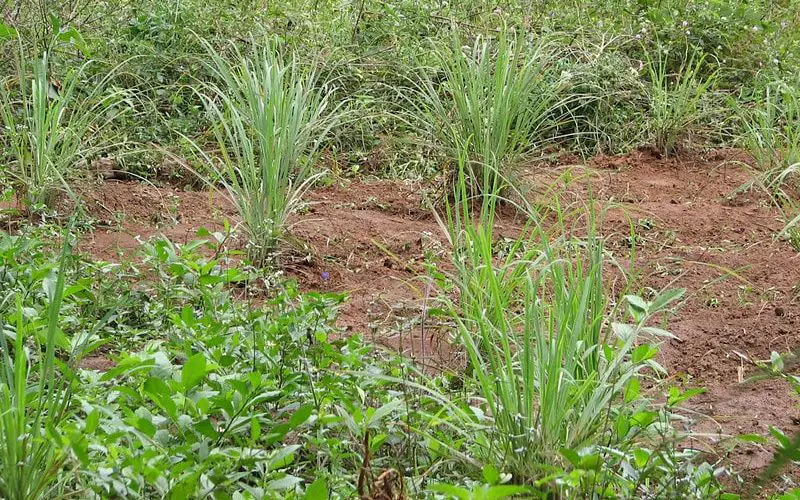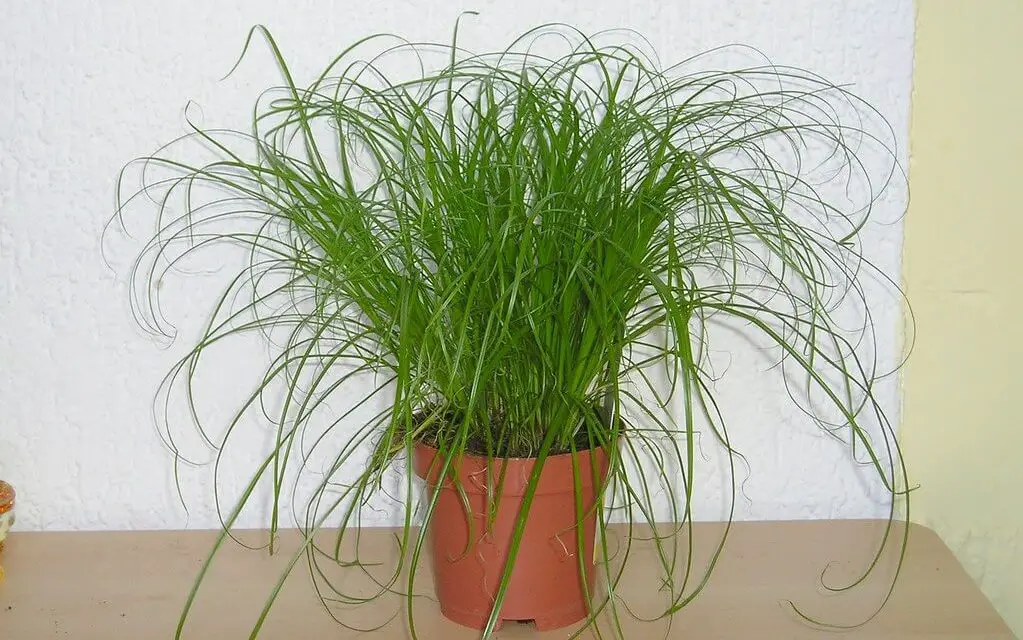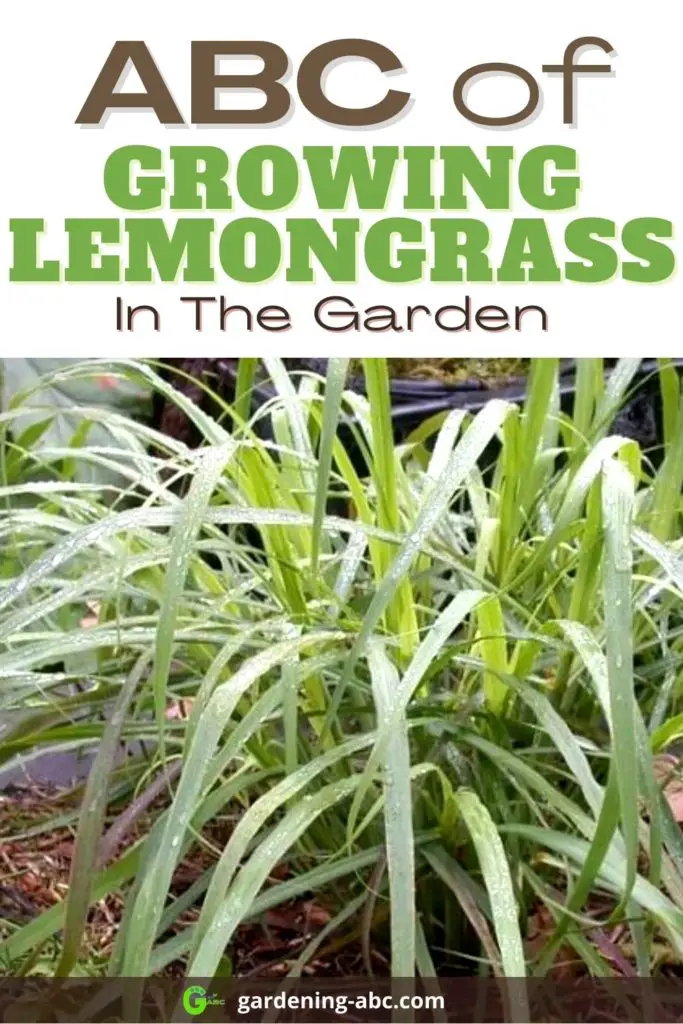We use affiliate links to run our site. When you buy through links on our site, we may earn an affiliate commission, without any added cost to you. Learn more
Are you looking for a unique and flavorful herb to add to your kitchen garden? Look no further than lemongrass – a versatile and aromatic plant that’s easy to grow in containers or in your backyard.
With its origins in Asian cuisine, lemongrass adds a zesty, citrusy flavor to any dish. But did you know that lemongrass is also packed with powerful health benefits?
From reducing inflammation to aiding digestion, lemongrass is a true superfood. And don’t let its tropical origins fool you – with our expert tips and tricks, you can successfully grow lemongrass in a wide range of climates.
So if you’re ready to elevate your gardening game and learn how to grow lemongrass at home, follow along. We will discuss everything about growing lemongrass in this article.
Lemongrass Growing In A Nutshell
| Botanical Name | Cymbopogon citratus |
| Common Name | Lemongrass |
| Native land | India and Srilanka |
| Size of the plant | 2 to 4 feet |
| Sun Exposure | Need full sun |
| Ideal soil | Loamy soil enriched with nutrients |
| Soil pH | 6.8-7.2 |
| Hardiness Zones | 10-11 |
Popular Lemongrass Varieties:
The lemongrass has more than 50 species. Here are 4 of the most common varieties:
Ornamental Lemongrass (Cymbopogon citratus):
Used mostly in Cambodian, Vietnamese, and Thai cuisines. They have a lemony aroma. and so are used to flavor to soups, curries, teas, and other beverages.
It is a perennial evergreen in hardiness zones 10 through 11. and becomes dormant with a hard freeze. They typically reach a height of 6 ft and spread up to 3 feet.
Citronella (Cymbopogon nardus):
They are also known as nard grass and mana grass and are best known for citronella oil.
Citronella is perennial in USDA zones 10 through 12.
Java Citronella (Cymbopogon winterianus):
They grow in compact, dense clumps. Java citronella has an arching leaf, and tainted yellow, or reddish stems.
They are perennial in USDA zones 9a through 11 but in colder regions act as annuals.
Malabar Grass (Cymbopogon flexuosus):
Malabar grass is also known as East Indian lemongrass. They have a lemony aroma and flavor with a warm, gingery undertone.
Malabar grass is a perennial in USDA zones 9 through 11. and need lots of garden space. Interestingly, you can grow them in containers as annuals in colder regions.
Malabar grass can work as a great hedge plant because of its tall, purple seed heads.
Ideal Growing Environment:
Grow your lemongrass in full sun, with plenty of water, in rich, well-draining soil. If you’re growing it in a pot, top-dress it with compost or worm castings every couple of weeks, to make sure it’s getting plenty of nutrients.
Soil:
There are basically 4 types of soil among them Loamy soil is ideal for growing lemongrass. The soil should also be rich in organic nutrients. To enrich your soil with organic nutrients add a handful of compost, manure, etc to the soil.
Sunlight:
Lemongrass loves the full sun. They need at least 6 hours of direct sunlight. The absence of sunlight may result in shunted growth and can attract pests and diseases.
Temperature and Humidity:
As lemongrass is a tropical plant it needs hot and humid weather to grow properly. They are also very sensitive to frost.
Fertilizer:
Being a member of the grass family lemongrass needs a lot of nitrogen to thrive. Fertilize the plant with a nitrogen-rich organic fertilizer during the growing season. Another good idea to feed your lemongrass is using compost tea. Check out the easy compost tea recipe in this article.
How to Grow Lemongrass:
There are 3 main ways to grow lemongrass plants.
- From the seeds
- From cuttings
- By divisions
Growing Lemongrass From Seeds:
The best time to start growing lemongrass from seeds is the spring, so the frost date is over.
For Sowing The Seeds Directly Into The Ground:
Choose a sunny location to sow the seeds. Put the lemongrass seeds in the soil keeping a gap of 6 inches between the two seeds. Then cover the seeds with a little bit of soil.
Keep the soil moist. The seedlings need a couple of weeks before they start raising their heads.
Once the lemongrass seedlings are a few inches tall, thin the seedlings so the gap of 2 feet between the two plants.
For Growing Transplants Indoors:

If you are planning to grow the lemongrass seedlings indoors, start sowing seeds a month prior to the last frost date. Use seedling trays or bio-degradable pots to grow lemongrass seedlings.
Growing Lemongrass From Cuttings:
You can also grow lemongrass for the cuttings. To prepare a cutting first take a sharp knife and cut the lemongrass plant an inch above the ground. The remaining stalk will regrow into a lemongrass plant.
Now, separate the bottom 3, 4 inches of the stalk which has been separated from the main plant. 3-4 inches of the stalk is compulsory for growing roots.
Remove the leaves. You can use the leaves in cooking.
Now, place the cutting in a cup of water so that the base of the stalk remains in the water. Keep changing the water regularly.
The lemongrass stalk will soon start producing roots. Once the roots become large enough to support the plant, usually after 2-3 weeks, transplant the cutting outdoors.
Dig a hole of 1/2 inch into the soil. Put the cutting into the hole and fill the hole with soil. Generally, after 2-3 months, the lemongrass will be ready to harvest.
From Divided Plants:
If you are planning to grow lemongrass by division, start in the spring. It is the best time to divide any mature perennial plant.
Lemongrass grows many stalks from the base that you can divide and plant in different locations.
Gently separate a few stalks from the main plant. You can do it either by pulling them from the base or by using a knife. Make sure the stalks have some roots in them.
Now, plant the divisions in your preferred locations that have the ideal growing conditions for lemongrass. While planting the lemongrass divisions give a gap of 1-2 feet between two plants.
Growing Lemongrass in Containers:

Lemongrass can spread very quickly. So if you are growing lemongrass in the backyards thin them regularly or soon it will take over your garden. One of the easiest ways to contain their growth is to grow them in pots.
Choose a pot that is at least 12 inches in diameter. A large-sized pot like this will give a good anchorage for the roots and stop the plant from tipping over.
Use a good-quality potting mix to grow the lemongrass plant. Place the plant on a sunny balcony or windowsill.
How to Fertilize Lemongrass:
Use a balanced organic fertilizer to fertilize lemongrass. Apply fertilizer a couple of times a month.
Adding good quality compost and rotted manure will also give a boost of nitrogen from time to time.
Watering Lemongrass:
Lemongrass needs a steady supply of water. The roots of the plant should never dry out.
The actual water requirements of lemongrass plants vary as per the type of soil. For example, if the soil is of the sandy type you will have to water more frequently, whereas, in silty loamy soil, the watering frequency will be far less.
You can also reduce your watering frequency by applying a layer of mulch on top of the soil. This will also help you to kill the weeds nearby.
Overwintering:
During winters especially in colder regions, overwinter your lemongrass indoors. First, trim down the stalk to a few inches tall and plant them in small pots.
Now put the pots in south-facing windows. You don’t need to put much water in the winter, just make sure the soil doesn’t dry out completely. You can also place the pot in the basement.
Once the spring comes up bring the pots outside where they can get direct sunlight.
Pest and Diseases of Lemongrass:
Lemongrass is not much affected by pests. In fact, they are actually used to repel pests.
Harvesting Lemongrass:
Lemongrass grows very fast. You can start harvesting even when the plant is quite young. The ideal time for harvesting lemongrass is when the plant is 12 inches tall and 1/2 inch thick.
Hold the stalk near the base and pull. You can also cut the stalk at the ground level. The main edible portion of the plant is the swollen bulbous base, So make sure it doesn’t get left out.
Now, carefully remove the tough outer leaves. These can be very sharp. So use caution. You can use the leaves to make tea. The tender white stalks are used in cooking.
Conclusion:
Now, it’s time to take action and start growing your own lemongrass today! Whether you want to use it for cooking or for its health benefits, growing lemongrass is a fun and rewarding activity that anyone can enjoy.
If you found this article helpful, please share it with your friends and family who might be interested in gardening or cooking. And don’t forget to explore more articles on our site for more helpful tips and information.
Like the post? Don’t forget to PIN IT.

Amazon and the Amazon logo are trademarks of Amazon.com, Inc, or its affiliates.

Hi there! My name is Prasenjit and I’m an avid gardener and someone who has grown a passion for growing plants. From my hands-on experience, I have learned what works and what doesn’t. Here I share everything I have learned.
